Department store chain Saks Fifth Avenue is Luxury Daily’s 2021 Luxury Retailer of the Year for its ambitious revamp of the luxury ecommerce experience, emphasizing service and personalization.
This year marked a new chapter for Saks, as the retailer spun off its ecommerce business to allow for more digital investments. Saks has not ignored the in-store experience, however, and has continued to emphasize unique activations and offerings.
“Our retail and marketing strategy was driven by the intention to meet our customers at the intersection of fashion and technology innovation,” said Emily Essner, chief marketing officer of Saks, New York.
“Through all of our initiatives, we aimed to deliver a personalized, curated luxury shopping experience for our customers with tactics like new enhancements to the site experience, expanding our merchandise offering and supporting social issues and charitable initiatives,” she said.
The Luxury Retailer of the Year award was decided based on retailers' use of impeccable strategy, tactics, creative, executive and results. All candidates selected by the Luxury Daily editorial team had to have appeared in Luxury Daily coverage this year. Judging was based purely on merit.
Spin off success
Saks made a splash in March 2021 when its owner Hudson’s Bay Company made the Saks’ ecommerce site into its own business.
“This year, Saks split its ecommerce and stores businesses into two separate entities, which enabled us to capitalize on customers’ shopping habits,” Ms. Essner said. “As our customers’ needs and demands continued to evolve, the split gave us the opportunity to rapidly expand our online business.”
Since the split, Saks and SFA have continued to work together for a seamless omnichannel experience, and both will use Saks Fifth Avenue as their customer-facing name.
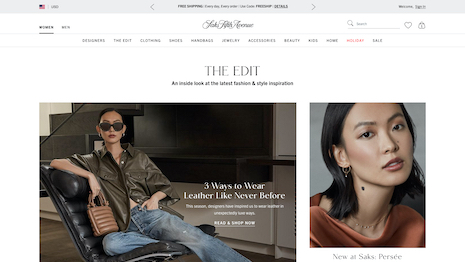 Saks announced its new standalone ecommerce business in March 2021. Image courtesy of Saks Fifth Avenue
Saks announced its new standalone ecommerce business in March 2021. Image courtesy of Saks Fifth Avenue
Marketing and merchandising are managed by the ecommerce business, Saks, which kept ownership of Saks Fifth Avenue intellectual property. Meanwhile SFA, the bricks-and-mortar business, will fulfill physical functions including buy online, pickup in-store, exchanges, returns and alternations (see story).
Less than a year into this new dynamic, Saks.com now averages 1 million visits a day, up from 500,000 average daily visits in 2019, according to the retailer. Saks has also acquired about a half-million new customers and has seen the sales on a total value merchandise basis rise by 80 percent.
Saks has also grown its inventory, increasing its available brands by 30 percent and number of styles sold by 40 percent. The online platform has also expanded its offerings in several categories, including children’s clothing, home furnishings and activewear.
The success of separating the online and store businesses has led to a similar move for Saks Off 5th (see story). Competitors including Macy’s are reportedly considering following suit.
To further address customers’ expectations, Saks is reducing delivery times and now offers free deliveries and returns. The retailer plans to introduce new packaging with an eco-friendly twist in the coming months.
The retailer also updated its membership and rewards program SaksFirst to strengthen client loyalty. SaksFirst credit cardholders now have easier access to more rewards, with benefits such as free rush shipping, aftercare services and try-before-you-buy (see story).
Additionally, Saks.com debuted a virtual event platform this year as more shoppers adopt social commerce and livestreaming. During the holiday shopping season, Saks Live hosted several events centered on gift-giving and festive fashions (see story).
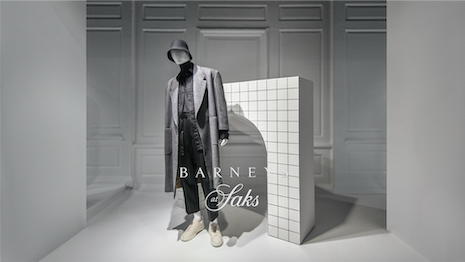 Barneys at Saks window display. Image courtesy of Saks Fifth Avenue
Barneys at Saks window display. Image courtesy of Saks Fifth Avenue
Saks has also continued to focus on an elevated shopping experience.
In January, the retailer unveiled the Barneys at Saks experience on the fifth floor of its New York flagship store, a significant step towards reviving the distinguished brand (see story). The first standalone Barneys at Saks store also opened in Greenwich, Connecticut, and the experience is also available online.
Reflecting Barneys’ legacy, the department store chain plans to use the Barneys at Saks spaces to spotlight up-and-coming designers and introduce rotating shopping experiences.
In 2021, the retailer also tapped a diverse cast of celebrities for its seasonal marketing campaigns, including Tiffany Haddish, Maluma, Sarah Paulson and Kumail Nanjiani.
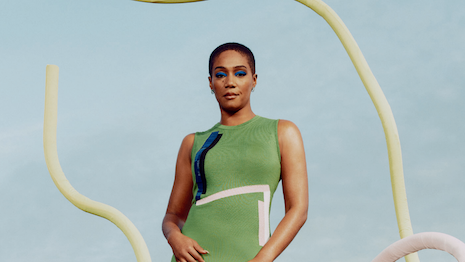 Tiffany Haddish starred in Saks Fifth Avenue’s spring campaign, “Here for the Future.” Image courtesy of Saks Fifth Avenue
Tiffany Haddish starred in Saks Fifth Avenue’s spring campaign, “Here for the Future.” Image courtesy of Saks Fifth Avenue
Finally, the Saks Fifth Avenue Foundation hosted its annual fall fundraiser. The initiative successfully raised more than $1.7 million benefitting mental health resources (see story).
First runner’s-up: Farfetch
With competition and customer expectations growing for luxury ecommerce, Luxury Daily also recognizes Farfetch’s successes this year. The online retailer has introduced a host of new services in 2021, many of which have emphasized sustainability.
In February, the retailer announced a partnership with aftercare platform The Restory. Through “Farfetch Fix,” customers can request aftercare and repair services for shoes, bags and other leather goods (see story).
Farfetch also partnered with resale platform ThredUp to launch its donation service in the United States, following a successful launch in the United Kingdom back in 2019 (see story).
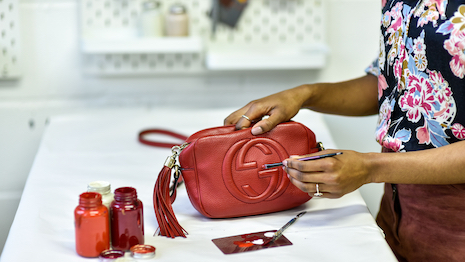 Farfetch has expanded its resale and aftercare offerings. Image credit: Farfetch
Farfetch has expanded its resale and aftercare offerings. Image credit: Farfetch
The retailer further emphasized the importance of resale with its acquisition of the platform LUXCLUSIF in December. It plans leverage LUXCLUSIF’s technology capabilities to further develop its existing resale service, Farfetch Second Life (see story).
With the launch of “Pre-Order from Farfetch,” the online retailer is giving members early access to seasonal finds in an effort to reduce overproduction (see story). Farfetch has leveraged virtual clothing try-on technology to make these online purchases more shopper-friendly, while also minimizing the need for returns.
Farfetch also expanded its sustainable offerings with the launch of its first in-house fashion brand.
There Was One (TWO) is a line of sustainably made, elevated wardrobe essentials. The women’s wear brand was jointly developed by Farfetch and New Guards Group using consumer data gleaned from the ecommerce marketplace (see story).
Farfetch has seen revenues and momentum grow this year, confirming discussions related to a potential expansion of its strategic partnership with Swiss luxury conglomerate Richemont (see story).
The retailer also launched its flagship store on Alibaba’s Tmall Luxury Pavilion, marking a key milestone in its effort to digitize the luxury fashion industry. With this launch, Alibaba’s 779 million consumers now have access to products from more than 3,500 luxury brands, 90 percent of which did not previously have a presence on the platform (see story).
Throughout the year, Farfetch introduced several marketing campaigns focused on its boutique community, sustainability services and diversity.
{"ct":"wsl5tb\/j5K76+3cRELF0yXzWbgS9U+\/jI5XChHVPCoMRaIGlSeBOZsmvzfnvH2yj6E3IYliS7a8vu2nF99KLFasziAkf7G0LfA10o1t\/m2qMadYhdWyy7XC3Flbb4SVzuhr3vZ3MzNKtD\/tbV55TGhbptsVsnOCsdqDpx3doLhoCSdpLDH9ksbAN4Y6OhlkogLqmStqj2\/undQslyasTVzYSpfxo7FafN+pwzusR+B3tIEIQ48E8P72S\/E8tYBNIIpcfOEgaHs8BRr74qE2M1qkfAqJNvc54Gi2kB0h8rEBpu6UwfVY6Ibw4Tx1YTs9jEfYuPLqYLs\/or2JMGCj5p1V1uYFtB15LSCejbcGpQ4zmdN6VurxuB+0XLyG2TElRXApMReYkRPL9mzFYg7lWY0cQIeToXqBtW1x3x5Y\/f\/f22GRsRe6KLcyjlLIR7X7cPv\/Zui5f09Si+u1zbLLCUpupNPMH9VHvzqnFmgJjZuwMM+8qBVQwEHHoglBG9wNXpX\/d0WJfK35DNajyOYkS85S7FohJoC8fUDR\/bCTTxRYpq0Aa1Z4PQSYX9bdA+wlHssa7WhM4OORRz4egE5yuJ9L5wek+46lcpSYzcd\/xHNfZE40aS\/eMbZHq3Jk8QnQAMCkRcrPBQGDNz2bmOiuSvjV0TuSQgxMDtvxtGNCNP4AIsrirvSU2Zr2vIqiXgaa05McqrhkxXJkFmQt3spqXeeQ9lYiju5wGSxh4mZ1FK4UTyOYMshW1Qp+hEnTof9cGS0vSwf4l5+bcPkKsBmBoitEvemM2CshozLiHQVNEKwTkDUt64HS56XKLNQJCfh7iWQtsnm0+SutCQ+MLYrRRgjzAVXAprGXFZCftuYwzEAA3yUtUQakLMEgSLINqWXExArGPyhEOtQ0osYnk7rfXgy9whzdJSV\/q+IIPmO+2S2kn+YzjRqR0qScnaNVz2wKqpygX5riXg7zl11vj6GFuHU1OWk2FUihmzBd9mjJnbX1uFDhxhXP854ZWaV4w72G7IhO3UCfh0Y8KN3b46PKbvCFl1RQXsffgBKIQJHbmxBolYzcz6mVBXBS8Ufc641004rqv4W928yULJ8jIO5dkpvn46HWkeRLSHVZ39kC6wB\/ozVUCrNH8eHJBZXc7CAIBTmkvmi4flsBv2vTfExuWfOfMbh\/3uk8KEgSkCB\/TcS3wWJ9waIXvYBh2iqNhlQX5NrL8UVXS5HT8bMHPsAi3bFkcaHZsM\/viZ45HAal50kUdHCuOr\/oIl+er2Un9e53CQo9Gmikz\/+F28OHUhr8xLI77FTajLugjZGxwpG\/AmslOu+q+5IhBO8ACvPp8MwFeuxOfNuu9dQza8vzMugSi2cQXNSt5tGpL2BAan59dui9+eaDxj6rYMwzPmed7MTHj92uCgG7grdh0fprWfriozF+Gh86Zg6oXvliqtUMF6W4b0FnV8kIHpyhm8\/pzE8UrigSzy6Wb8szs2iwuWtAWD\/MC5+1zpZ8eLutUnaXKeSq\/YrcROMlLNsW41nvmKlsKqBbAn2MIg8\/ncqmh23fg8yCTU58nuOLqZp0E1Vur69Gy0LKrAcHfyMNr9WrmT1lAhQb7IE5GvNkZ7Yx6yIaFrvoARr04ou5lCWkc3Nf33TSK7SNU0E2xZsTzZJzVbGHLrk05X435Zy7SihRoYlaKuPgRfvci84Wj2DCFh2WbD5mpq6UYTcp8JnSksyz3Hq\/qZbVkC73tkI8tEmbgxm3duUxeNnK3ioR3qMq1ExXZXeFs0w9WpEatsgJxqEXgfrl2GzkcFpC4t1+I88z\/ZN5Ee\/miqCFIVN05lGQ7aW57O\/zy3HSwrk4ZabiNJUnhxKs6ghjUK4RFrH4TfewT3euqstWuCTH1+Ai8WG3M4L+UQVf2\/I4g5WVw5TcGgwlc19tNFWwtH4qYqQ4\/IorTLm4y1k8eNDieEcpuQoVUCS4Hi6CxNwQc1ygYbFDBxEp8FcRooa9WXW0IaQVixAMHxdkf+DCebZibQONit9pRiaoYY6lW7VEe8\/gjg3+0FVRuag3mHDZWvtLiDwQm\/7RdGClrxSnRaTzby6orGPNMxRhnIn35NPKFRVKDFF7DcOYTFeln3DJdwM+atYAuIm5EKlDXKIiuF\/wUCofKyxPr3pEOsCXyWg6nhg0PunH\/w+I9mnhSEq6toelWPWStIH3bNHg6cEm3qiAVVSq7ki7jnsjSTIe8xfyMPJ\/\/14YTbyMyq6oYGsMuE+8nN\/pc0\/3D22KtcBpm7E1trR1u5rf3TGQt8749LDL8+CrrBYBwA2PdWXqaclK+mhrQRLgvhh8a6n5lW8cXSGcrm0zVxOj8Z\/TbfIBL5cZi3ONxpxVnG3yGg5LJiM3GsXHJuOroujeNYxbalHNTpboO4xdyRHLnNfskhcx34jsEfxx0hTiqAz00P2qCSEV484wFNuugiRR9zQnks0DTsXdhxFpjFK3oRRqnRGLpG0Wb8Pt6JIvnBkkfxVQDQ7ciml+xPZmYttekD1mx3pGAS+uINQNh0zTryd2wH4UlPcJ1CxRy\/aqbTMecYC\/t\/f4rAPiQIlhqZ1xofeOiVa2doJkz\/XaVf+KGguhhXuJCg6S1QRUvuqQ\/Cq3dWG2P\/iZn2iirwVsFd3HIwQthCjeLmxT1+16wYP4XzHWRytzoZQgL\/L3dgv84+Bm\/V\/0eXfYy5T5u0B3Z1l8VzMvYqwPoSfmeBDIA+rVTGi7iv+7++uyPNGHXzXlyyk2OBcRBuOY8QklTUC1Far0ZU0AT5zFuhlWXytQERTWZRScTwN27IPmWZ3U9qg52YocKen5yfV6of3k3nAiC+Q\/CwLZ7yYQzNxtVhRfPh9LKQZotS4tlqNueWq9kJHqLjzL4gnDVu1SrUMdiW7prsIBZQnkj8DvpA9G2xnbK2KFJoQEpIBEjYvQeYWiPdAI3c6v5kbfS70HTiJG\/xUN3Qi5V6HMZ4cttPmp7UAnINNb+1+OJXsWVwscopGsyZAKrfCiMIMbNLA8WRuzy5GfoCfCxZSh\/Hq93diWXTlZDJw1i9h\/eItc1qxFP8JjDUoUUdqX+OwMxG8myBof8cgez+PCDw09Q9p8OfeumTzvSZoW8hCkbtWn4U8tpMIUmwrYb9BoBibTsOLjVr2rrizlMBiubi+xNnRVwFRIKjgTTMHcymTQc66tQUVsfWZPl17J4D5Ms855+IpKy0aQdbun8wEfspgqhKR0DSpXLEZfkaADKIN8Bwin66N3Q9EsVB7D0y4hNvZSW97QvDbISiAcQDgpbdbVB7jjR\/702dM9fm38eZ6OEuhMXZZKb\/EoCBv03DClhmUTHLYTz5cVS06gWVzbfpHXyowR2kwpJd5TrY6X+qkPrqDpX221i3Twlg+BsoXmxH1BVN4ISRrhB7NJymkJyT4hyu6k1zCnFwA58gX3eJ8VMz7+5n+21xUpSgLnIt2qw\/kkE726X6k5dodew9cCIdUPKz9sFs3S3vssYU5r7jlOeTTBdoHcjgKMBhEeD\/Miqj9cozcZcn8aDjMf7GmV+l+KEntwKtTN5ItRdfDuAMKDslC9orLH43C9qkuyJFgXkMtPboT\/+ViA05EoUAaHWdGJ+AjFQWae3q4CspTlBebqge5IbVOfUhTOS0AND3zQd\/6ui1vgJeeliPIa24UVVlksdgQ5XRI3uQYZ1tJ+cbjDHhIuoOlnh1Q3fsIkijiCiq5rOUBh6EovThYtnzfBH+rSXpT0u9tde23VtfWOTUxz38HosYl8sibc7ztpT9JggAr6gDqUU+jrelwFa0Q5gVt\/cKJROJjRKjSE+D9W5kPRNpufvNAxNiK6w8v91whzfmTyhY2BdAGnVH+w3rlDBnl0hMx23Bv5wdQ3QLWUJVgkgl3zQuzMxHU3AiRjpSQ0G1a7MGvPvFxk98iSYJr2gCLf3LbVIEiirR91dOXjDFSEhiFgSt9zr1Pvjl9xVwinJxN0NxDeyEtTSQiKfVaX34\/nLarC9DWqr2rOmUcSkYPti7VCpx0860SBQyQQrQMeYL00TMudKOJLekbTenLyDAEDvrzxo4HvRxWK7\/ErGVL\/nT9O1UnnAuLU2jo6NG62ijN2ZwyRGvrpnSpWBrmw3ilrM+DaZbGRMxV4ZW8QTT5627284PSxFQa1wstbg9LFRfMGUQhCnjz81g9Iio7U\/UeJqLlRFniqz57BxbIpOoPxKrVlWaFPpQt5hh4jvcwHngRcCa3XD37VKIhkb8oqeTCCLcxt46eooH3\/hfwncbmxS5Ul44AIIStwc5hhAg1Uu5FwVmPMqnweOECKClSXv2ytoOQEwbFtGrFGl6czB1qJUr8dB1EESOyFOChq3Ygrjr5zxq8JsylJ8XIjfKzoXDVXkU9AEVS7cTeIa\/9BfkDDFODdWrrVpNspdai8t1o8UK+mn8Vkhm2Bd7Ki\/4HozH23u5kv6QtJE1TkofvcQ3ZfOAREkov7ByeTkDJUUod6WDquHexGd75RxeWu\/a\/6I5OzKZShTeN0r4xPawl3YzTqwC6bhs+ph0FEVVKO2aQNTPO3Qk6MuBljW9bpC9fE+a4LULV1s3hPnG9oEFoF4135TyXXKBfLkgTokIuMsVCpScd9t5AIaartA5VTUvAJBkf4jhyPXEno7JtESd3Cih2wR7f+dxoIIEgdcZ5cnXUfyywJjvaq4c2xdhQODuRUqW+9XgaGL+91CnJSoxNwkTo1ho21\/o72cj+q4xTkL993qnhAnf6ko+c8gQvp8Iw7yLSB7ecU5HSN\/jTEoCLTcRi4rT\/1PcrjAIlHgmT9p3eeywKCA1lktjUUhNNVg7yN7MSwqgRtJtmEi29GOb2f8je9E9PeVZ9w65WM8FXEoF8Az5tgYEMApuHiZwfZMcRggjcqaoKZxFrmnOwQrGULcbC0etL9WGb+5SExy9M3CDReIfJG04SnSRP\/\/zXAAaDQZ1r5hWaP2czOxhbbTIxDXFvG6i7KOVSMAGKDtfLrRz\/Xbx9Sea12pjBgk1MMKVAtAu8jjsFTpsLt8PMrG51UkYgxo9Ex8bW87bTrptayYYMaYaud7979UE4S\/K7\/TRwVOO+nhfOVN7FetheyyKpeZl0d8xSp0O4avRmABTR7Yomg6PSJLhC4PzZzBnV7ILHe6ASBTEXeerjrjPil6LPYuLbFs1O6JnmA2w8lHp0n+7apzrKLWQUSbyDg1QsQX2IBfhDTEQ7kpmgYI9JbeYlWlrvC3LZOxrkoXfbgbPETkObepgh+FaVA7bZOcW4IKCoAKGgRxklAzJmNDWqsXsxpbBtGsTbzmsf86Xh5xWzLot4JAeFxfSe0HSQepPzVMz0\/pHNGvTr5YczYf5DJ9ozTexZZhf6J9mQSfRb2DJQNCpQEWIXbUbUiQlBhQnCYPkbtK0\/JkXZMKlXtPP+nnf+hAp4lJvicQGq9MMq7IourCRgKFc5V78P2AFbBlmgHO+ibp4nGBv7nbCIEmdi4fv\/9ZxOAz4tikJl4sT0R9jEvdm8JvV2+CieN3YHV\/nL+WbB+BLUrO1hoI6tSTmmdGQrOr\/OowVPgArclBhETmk98\/seESdhjJQ6ri\/kFdHrUkBO5z72Nu8lNUtmlWzf28KAPXdaOR+FzOlNvPbEY90kUbWHimU5MqUMRUxbSdnzJCQ0kwwSt00u\/vyQiDJGpdDRzCTBgbR1yHCJMJOlCC3L1UlnUPlNsLz2capizZr1ioQ9kiEUJSAJmgRqAZP+0m76xIoT8O1CT7KWEvFw13G597qRktKogZgqj9W7NQ65K+A9GHqlZhxqVCQDi2hA1afcx12ZY0tdV6ZAJUAavG347eIMWy6EAAi6dtyvgf+iTAio2eahUSVNI68Rg+mOztlRa0qSBS5aUw6m8JcALUX55gtkC7P3Aw4SvEV4zrTm0kKeE+8Sh83FY8GnAEVhgryQ36rCkG\/DHIWz29ln+UdqTz84HqETepVOG0XT7gmKThdmEjm9h3DzM+YZGT8YKMTZXXsJHL\/tZurxpPlWkw2aKYtieq\/3MPB2WLzYYc5ZSK6yEa3FZGeQBhYsvs92zTeVWa8oY1X7fRegJwmfmP5Rlso2MOEY+1cgIJtHT8O5lNsgKOTPwJ37u7xD5pklWms1VbxHD1Y3gOudPugOHiH8B0CoudF8C0Es1rYlT8PkvUlc47v0GtQuWuQO50pfeClLj955iGAsFMfmCYgN\/4lXVTgRsFSEPX38NORftEPx8A4bT2V6riPhn\/f2wG5jRnt8csjK4Ih35jQPUIuQhEhM\/IQH0UPEwidlsTbyq0GvuhzOc1xDw4vfOeOgR8ymZlVdSmUqPb91zdGb1Zyb382NaFIOqMINMRgKbUwbbXY\/eBqixrVi4LoWwj7mPTLblNTMsutdzAVp5sYMftellF3umreCXVIagWitJVf+0SpJkziML1fltwxw6pWOPURMUGNvXDGSNYjEHdyo1RU0MoHHoNzeWIkR9A26tFnDfO8ndzQ8tO1i2Iu8ujcHAEPs\/R03oLzjIf0bEhx\/NPFHrFXs8Sz5Iqmg2\/ikexBz2taSMQ\/oXvfApdW9siPPlm8aji+FxWTupXXu6PyVrsCVhuxoMkeztvTJVvuHoEZuVXRHPwlfdAkyQF1ZPTh\/sM+8qSRuseIc3DKhHvhQ+A3KU\/QpvlP6Lwg5TZsqN3q+yuWOr93R2YH+53Dh0qJGIhTeizaMl1vGpqC+qq+SOAej5oL96DpEUhxBvM6g7r4UBmN6VTCD1JVpyaQlnejLqKNrzLGNwISU6yUL3BngZl86rKsw6Cz3gZQSDsyVfvz6BZXRhjHQ3NPH4rFGCks4HrWZaCm8SLvtecXqKC6FxSnLU+ayVynDhr265JSo9rmcKQv1Q6iukSi696F467mb1\/wrPE2+tPNrslEY+BUsOjBmBOd0XUp6VMtg1R+X3s2xRgC5tFEI\/PWbwpueH7sm+SJYWUwscIiCfKycPgEcf7YsjD7KOOYO3B4AK3MIyIQhM7NCUK9dAiIUw+KvhW5m7XGPFibIvlFq1bVYc7E5LutZuebfM1N65RD\/uk1bfdZZ4WuIgqPVdyF3aaH1Kt\/wqYUv4D8E9mFjmY0MKtw9NZd0mZ22qoGrVB24IGgsvaFMr3kleU2rj6zO1Z1o+O+cV03La2aGUEXqbGCEp+jv2heOSKBw3rKLQB54Cq8vTIC18NbK\/ulFAu5SPdB7\/WsZr8oB3PmPeTwpPnUQY3YfDTXjPUZGZbtSuvrYx\/vPAiFrFOhKYWKlXQaihEDxfu8nMwQAS3TExozv6aY0of2EGMM2532BAh9grp9WbutxZRm\/+eHTgDcHyReKL4uEwOVfk2bVxy4AsoxzbhGVgpPx\/SvkZPPeqAL\/KJXC6XWtOdg4+30hlfDk0aqY+m9uwk1j+BqL+38A0nYsZbLsH2uO8XDMBK41W8EKPvdnTpp4eopgXRoxqxpC4OWNu36sr7NXIaOasMSacgzFkAekKzqZLOWlwVdIsyXbjLy\/SCneVYyLJTDG6q430jr2D+RVZHBWOPGMLHdj1CZGs8\/KHTEKD0ztzG0aenTuHl6v+WmXbylCPIYS6CNfCe0LGlhYat+zuQ63V9tZ3dzhNQdNXkXOgNpG2mKlGhgikk4AdWZE86EjCeYS4LXSk1cq+OZzdI4UxVg3kMcxs9Gm0K162GImvJjV0piLEunqporSCYVYOE6FwdqaFLwmlxzG9ocTa1oYfs6XM7huotL2r0DpBWiPtalzh1KdfL5jN2Do7y25pgZvRxO3bmW3jwcpVMXT40PE\/6VXa6\/jQk2UTvMxGIBl+MqYG6VmIiUI8gXggTD\/lLY93GiKK6Tu6ArYpNuAOWmTduTfwyyykgIVcth1TmqZAHZbvYS7ymguIShMMZrPR\/ZVrMjM8Zoxx96pkXnZLOyuBj669kttuVM3CUU\/HOGdw3mJDvcnbX9ovOSbVadi0XF8ubQBLSfGgdtnJb3ZJcZy7kO1T0xqDwspEyqrkqH7JkRTdZi9VWmcFFH8cugXV3Wk8pPSrTj+mfG4Dv8pBCsKIKmrSmxu2U4LjLCzj7sifk9bl2cjS3j9wFTK\/DYp2QDAQdC+b2mxE5dkSZcx8c9nbeLs9Ox9vEXnakdJXCwwYKILV4VCX3IqN2fKrz22aCeCrFXmKCCADRBwcY33E8JtfCG7u3tTgH3t2gzub9VDZ7pIvPAFJWI5ddLdXSC9j2JtOHtpTN\/UQmpa+hd2UUDeNL0crwB2hiM0gaF5JTMnd5QKV4k7tLUKYdDDhQ2nervLcYwZcBrRS7j9N322igRz2PyoRX6iMp1Ffy4dnzE6NxeRQTsZHSJeHPqN7U9sCBr6LPiRltACdkzoX05Le70Up55Sal1PAOO0TVMwbOWAqup7xlGRnmp4AILjWUigwZlKLlDQe1lG3V9yd0EOvd\/EQpRUzUqq43A7d52I1mVMGyOvldwh0XZspWb9WmgeHnLd92bIWVe+xIEwjY1AnSdDLqra\/Gq0ZHVTO1jPusmGg9UuGxijPaVFNKXRewLelcpBLgb2FlYQN+M+LSSEW9FckRndifPTa2jwqLRhlL1wGz8vqHUZoU+WKXmquXvPvL9JQDVKVgZ1hRVN7rlcVg6ogCBTt3lOId+4dM70rjDtPhWiUyJh8TrKLZeE7c9DRaJBfKD7H\/\/iff9khhJxvCh57jJjLS\/mC4junB603uYN3MpNtBR2PkKhnbWYnp7UzICpiUX2h9Cg9VVQaFhSi4VV1KaLuyzIsShQjLufsQeJUUj1ZQm9AflW+EbyrXbklZSn\/dzQ09MHrJnxGyEfpwRMzZXG0\/wue0U6ESj\/MzSrnE3AnElUFyk19BF\/Sd9Uo5W4fdaTpldDM0Gdu\/cZypd8I0yJC2w1jwlRGWAxJvj3aGBbC0THnJQGtp1FdjwTw2oFUA9jZ7vhCqnnvkSCftLOO\/3mCGTx9dDrB1\/Va2LN5\/3GgNpfviQvFUSE8Fq8Y7vFY6E7z0\/wkZu\/+5JUhGZ5Wxjsuq30BDhqWrt1wYrPPbMepD7wEEtTrHVQRhFwmm+f64gE+t3iw7mq\/2K1w0ukcV6i3QZv4UMBXEL8J6A9+EZdc1g+vp8vkQKxGe6LDxwXdTRD0uZlZzwq2GdUWGPdrCRfRDKfbfMu8Ry2RZPiLIhlINKbPralyfyBzvTNyQg1estGKb9fB1RT9SjrNVPLuAxwEubHPR6Ajnw72seQOTOlJJgdop3\/TThk682kmOipIz+dnabGXLSHqEiAyIZq5fR1e+sUaJSRU52JGDkTjyIFG8l74p+sd8rYW2MnIvVtp9++HQZM4M5wWPK\/VdAxM4TUenv456pSAN6Z4Vm0QL6W7WwVIW9fIoFPPsSa4Lek46MOQa3L0y65gn8swNNl42b5C6ITbVKkXya0NLDltRQTQ7uX31Dxfw3cdyI1PTn7wZe8j+MA9ZywMVLhvv8jjAsI8q520J5pSeFM39MID9J0HNYF7QcjM8m4LYEbkEskLN4o6iIUt4vgsgHIbiH+1bNfgRGv\/C9pZGEUnxluke+uX8DKVUgzZ0R+qCRhiQUJ6wdA64\/fB2ruAA+Kpjk9JK86RFkjr+Y5vS3lmgdDxO21GmioexCgkEkbD91cKOXBx56CTkNe4Z5htREWz4xpREPi7IQBDlYbhhedX7BMd9YCP+D+9znwaZDH8R9jtoy4uQ\/Z4OBqmfgiZxlLzfPhAQbOQh4ZayxYfDi1VqdMrak0v\/34O7pLC3HgAAfX9JnN\/TzTHB1bdmo+8BWG388LTuYzv++JZsOztSQUOYxs2wTfRfgAUfsIOfVdEBxUcrZi9pbXLZ3IcYPg+4Hhkqiw8LnzxrBTXcpgjcgU6AW3pjADJzstOUq+kBLGAcWW3kf3xU2Qp855ugoWWCZvpW1GpH6K4iWRGQtagtmlxHqGgeTYY8skokxYV4X8bMNPUTFW6BIt64\/1Lrx46lMjW8Xi+J3ZiEzsA0\/ESvKicGaAIUSTzqigv9mskCT35JOd9TmDXByRcc0izECelLy4NSTV2DHvDzYzcll\/5mlL53k\/Fxwjy0HwM7t27CqKIHa3dJxaW44QqpRKAmv6aFHGzw50LLdO9l\/55+b8yM\/7MXFP9Z0h0SrwzN2Z39OB\/hbd8oc7mv8LoVuBzZcsoLC55tysoMDILteYF\/aLHDpPdlQnifPds7nbX3ORL8hcmMe2Ja50ZzBaRmEDpWrADCAwnUSlzYRZTNOcbhnYsnrxyO8hoi\/casev\/QniejOg+4nkS5dp1PCpQu7D+GcSQ3zh8OajEnJb7VwPnRDDqnLYY2QOLLbOi6Ea8ycz4\/XBQJdcQvH6X0y\/qB51oGNcdxIxcWNADAhSg6uqhOVq2MOvAKudhI\/BGY1+J\/2OGj5x4uto0XBIP+ii7kOjfFp95FPhiJrlYVepIsJPxncZrV2OF8XKBHgJ2hG2XzUnaHfn8gzG+udYhaTFlTG0447pes67DwYhfxYHTgpfZzbPxLJmL9AXIWbQ5uAcNMol5Ix+QYTOQk3f8vPRZnL5Ktn\/\/9wGoNU9dipRAs2P4kU0g7uS6QFf4hd8WFPaDkcxSOUxhnCAuyA5mQsUapwi3s8RvMZ2fclx+FkYYEunlgXq45MjVMg8OvRyz+0jnQAPkelyJHpfcR9shUcw\/T3Dlw\/Gc0GY+EALl7Xy\/hTsH7S6IktB\/5plcwRwa0yokLmLwo8diYJKa0JWK8Edj3dezrL8mzE0eGij4xnZtIVjWCUr7QKJiDqDZnBQ3tjApHMM6fb+DwEox5WmBpWCX4QZ3FxyCMhtJ5iQlnzI8gZVaivz8amCjRMsQ4T3nHxAILZ6SXXVCDK9E9Hh2Xvghc7G3AxhR2HuoZ1g2Z5G048I+MVSFF4ekKFt22B2cR8aa\/ddjDEIMi0TsRw0OfoB+ZlQ60gL6p0vKS5D+PNASUDtZwnNxZUUNMbiSOkupFDDGyftg8Q3ZJQYqCYIRJMG4zwc8IedUvLKWG\/c+\/ZUP8rnvJD4qzqcz5HYd5\/I7kiV4E636R3Eb9axKpZzie4YenBjtTy6ytAV5G+SgO18HgS7prIHU2x4kD9uE9Cjlh6YcP8CBocpIhfrkRvcZ74jAX+n5zDgkj3\/ZBg8bOFlyqkK6G8vCbG9cmcc2W6Li8NuAwcCZ2k+hy6JQRW1GWyezn296c4dfkmIj\/fgzsn00LOKi\/NUHxOaL5aa9yUJKIN2cnT1QvN6IqwLk18L4gpGHXeYMwrGKJJh01JsIpRpGaUTW1ZIUnn+XRsdqqBd\/6\/fZX5HCTgAebc3SuOR7Wk0P6H1T6TWXIc+PVy0oXM14ZLGtqpMu847jLnMlvdarGVaTjU0Radr+2pbFCZ6qYApmEPoAVCqPICw9FnyQP431K6lP+Isghrq6lnKFoFXvdXLfvVtt8cDqmrwjpGOKjFLfTBuomm9KKWjyJ8iOOp0ZVCRV5vYGEZT6EqB5eu7aqQS\/4RYbYPZFDDHaGgXvccHOQSLfTFSwwkSotZ83KDnBMcYyyoDvX3XdExkJyqZex6xToI8yIe+J5vh3M9NP68Nn4YWlyqtUjppqvzlM9fRgGTGuYmb4n2GONpigZOfw0C56+YwHGSr8fjEwdKKn5+oKFlI+L3buSD9u\/fZcvsFjfK6cjrEzVZxhPq0i8QO1rJIIP\/qB0g+ClB0KinLbGFsqLKYZ61xwi26RYcu8S+sQlvZRohWebTrohYhDLQDoHoZsJQKHxncJVl8gIpNrCmWgbxE6iGXWpin+DXOABb9XEnWadac1xemGY3REk5X7jHANr7k9P70K5p+LVH+9o7CDOAAYcERCuQ5moqLzBTv14BhRvpCajUe47neeN3lDifmBcqOcdhgLgeef3PPZvUKGpBDHtS5TmgRSH1V6XisE1RmWbbYlrSODib5AlOoc5ZcZAvAjDvVBbPmXXBC8tBNXw6QNMWhEEhkEV9PQ+xocMn3wdtnMq\/gYAhmdHkPLK9ZWThMAHOtqRGwSliB6\/\/gMPAhQCYrQlEm99jUORIgBP5VF3\/9zL9zbrwtvtJ8\/29NykyG9SJt4cUjPrAe1CwFIEX0j9PUIfpXEPtLNt3XhyI+snS+bqalpz3chQOcehy9LHwyef38jRWXODkLEhfMKUwEUt0\/hhbYvWrXb6hespUXgkGlQa3CAUOcy\/OqLZWzcnkWuuTFIyiL1SnEIN9zaap5zMKiUrSuiNzR\/1FcYxLlbDYW4TrfuSZAw\/UXHrzGADblIiqUoUrahfn8cM14+Z2I59256p7xvgAHTyEcjlpklE8dCDzfKI\/Ebiq8uwNmB26VsHYblZlaeqgVcCGTinR6HoUG4kQsJGQsHRVBDLOuDYh+62v40A09CsBb73ckGK\/zrLah87iyrkyHSCle9mz1zEe90y9PI3wNKl9CyD03ZiHg6LZx1YvIsNbOTuySrqzQSDRBX0fueHWJwzLNbMwCVpx7lheBkxgu4+jgUiVBeV5BnPapsEmCINVjjevTNIdq4L6BeNz8e\/bjP8GggPf+e2YRKMEV713V3rs0n21nCYJKXRQkFajRaTRF1DRjOX9acW0p8RMfsnmOviCQFERjU+fqoIvabhmOpXMtOtWSZeJRVx\/UsdU5r7Oo2Jw5Kwjc+yDvoR+3tRON1gkMj+sxJE5RlaO55lggM4RWm8ZyXTXDjvRVWwxT19M1hrmWrlEAn4IBLDmYDKOiQ9ZRvfTtYutoC4nvX0JROjtyZ5oBOvfRHrQsyx6Xw4boeYx689by3bCt9GQt2ASk19pilaaCjE232zCN\/Q645XP7Gz65cWMcnoajlWVp0ooALLbwwHQ5wpd4XKT45od+kd6eClkf73OJKzF\/ipNe9jf\/0nglXxY2+TKu8CNiUF3DqpcCV6dq87HYGgKMlobgYsWasldd38UvaoZAeO9N9XtASOyQHR4Z5Th6jSBHb3l\/gajsCZZLz6vCgFgw4TIfyze8BNYDCMksTU9kjDYiriQYB62r6AyW3pG\/3BhZyh86+leqkeEmx1Bg4AFVyuc9ujhwST8R974S9xXJIJbK4HioEdqPskwb0NwdpUNlIBdqXIF4gd81WJlt01owFaCXMBm1DtTANpUQ76VVl37c\/h4Qqf6jMwk2946baFWCM7MJaVut7WuC4MT0tw3IqX8powGKwYojnC6SjLPorBGfv6xVHFjrcK1zWL0nXW9RrkSdGK5Fys0P2Ho3whf3xedqqsmJZ3npSbaO0aR5lKwagiH95\/9o0doLKKfljM3HmWWdy6YtKIflr5gnps9jFdRrDe\/s2zhrvLZqsRZ+9n5GlIBdfdQtfFPTgnIn4utxCj+z+4dnbWSbfFhUDfOsCsFD+R0JKhsFIDChUQy9FNv4K\/nZvk35ChMMaKDWBVVXixipguwXyvbZ0jI1ARCzr3xIulCdkhxNHqYJN34aqgBqcVKlkBjQpSRrdLFELGpzoYg9ZVuI4F5gXjb6nc5ongTZVucQJfpbd03jcMsjdNquzW5vPBIoI7BgpRBVCiL6co3tIE+TBElIs8PH2Xu0KvFwcEZfAAzzA1Az0p6ccBsPrrDnPy0wQf5G++hIJ6I21IdJx95Iuui25fvOPusGwO4v0y5fAa1qiNEb0fvBzI5yayGye5ohv74+Z4oLPrkPq+1Dg3fgvmsioSh\/Y2r7E58nFZ9G7TxET1CMkZi\/2ru7K9cjll9JL7ch\/8SpEBo0oR+ParJDvNqsNh4i62nL0ZpVQDhZ2lH9I5g0HwpvdS3B\/HXcDrVbnyhJfqJvQx0MRr7jKgw26qloSqmW\/ec1Vebypr0jtyhydtcmN34Q3mY+7yr6x4N+WGli3Xgtt1oHNMHeeGrQwhc93DztO7zIjBFDvEYRNNdFarDfWwKIPLM\/qYtra9NgTcTIHwJBDdxSYQ1Q+4s5YCeTWTes9+S3uugfWKUa8tFNaaUz9IWentrsO+4hHaq7+g6Yo\/RJjIYRLZonJDlNOA+XZKsSsKl6h9Q8TprK6YBoQn2Iu96syGPeXssiwk\/q4BD+LKQlr77YPpV4OdQIR3ECCYWEwUcqENe+6cSb6spVMYXjIbqqQttt8vOgccKac2bXEt3SEX4OBSVvNmR4BVtaGCBJHocwCWpQDSTxa01P5C6ny8fAIyxQDMYERVNP3VvOA0bFICLEOMZwO2fo0+wjysDloq8Kpnmc5V0gnxGnBn2DInk+FFFcdUDOlHnnqprLiza0FvrjD7rnBGudAjBZUSCoyogaXUfQNb8sYgi61IZLHlVKHnSVxA5Zih2VK1W5iGsy1ImxHx\/Nmr5WjQy5OOgnpWH7fFiN4Q19LXDbKTncD9iUDiWG1fNeDWGdOwr+nE0TT86qygcWNFwKuuwlXnJ99ZPrBzM6FB8A\/KeLfHOPmpbDP4h5cLW\/wv3dMrWU74fS3zComi7Tdx\/KAnOaOHUm8T1nnAVzPkvnskKBpvq4w+zIXlMkvqlhS6gnTyS9UFtbbj5GQAXVvNKAWiRgCVeSSDrmMlfURACvjbd7slj6682QnW\/VD3fMi76c42oaswjzlzBB6mv8BBTc2WIHubKye\/VusM3QzuKcSKsW4HKp0lxsZv5LBcpUPGhuxAFfAmvlHwL5sh\/PUHhoKwuRLMlqLv+Af5TCRe7KB2daj\/yWHvIabQxtDMHjhWloBoLMsPb+9yKfSgUnN4VdVmOtvTSQvLF3W39w7WlFKJuylEkuZ6JjNB0HFm7QXS5XmGhhZekSF077FbPi+ydYxyW0L0IS8VVULMMeAPU3ZtQbAVyO6VnRo9YybCmzCGoxZwZVba27kuCnkKXZnfzalpwd+2yXLzizue7LCcGU9Lqk\/yj738XwU2jSgrsOmQGvq6GEYI8BO2Ohbi8Bx88FAxBAtsbzi6pXA39G\/\/gJbJeqdHdEZTslsPdVh1vN34GfM4HsxN+X51QEcOy+CABXmBJ017hFTz","iv":"e56d2053c82a0b3bfa547bbf551463f0","s":"f2ca0156d3f47a6c"}
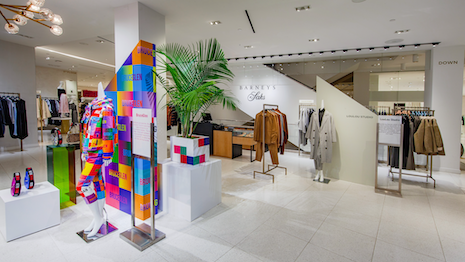
 The Barneys at Saks floor. Image courtesy of Saks Fifth Avenue
The Barneys at Saks floor. Image courtesy of Saks Fifth Avenue  Saks announced its new standalone ecommerce business in March 2021. Image courtesy of Saks Fifth Avenue
Saks announced its new standalone ecommerce business in March 2021. Image courtesy of Saks Fifth Avenue Barneys at Saks window display. Image courtesy of Saks Fifth Avenue
Barneys at Saks window display. Image courtesy of Saks Fifth Avenue Tiffany Haddish starred in Saks Fifth Avenue’s spring campaign, “Here for the Future.” Image courtesy of Saks Fifth Avenue
Tiffany Haddish starred in Saks Fifth Avenue’s spring campaign, “Here for the Future.” Image courtesy of Saks Fifth Avenue Farfetch has expanded its resale and aftercare offerings. Image credit: Farfetch
Farfetch has expanded its resale and aftercare offerings. Image credit: Farfetch